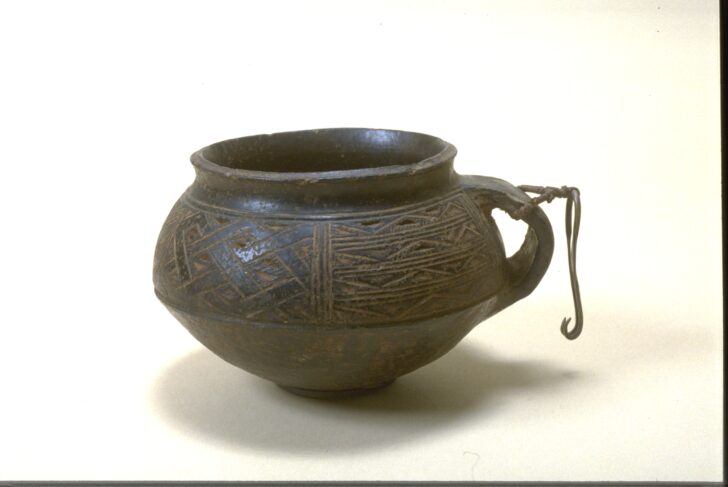Pot
Kuba

Description
Subject Matter:
Kuba artists apply their bold and sophisticated surface designs to both ceremonial and everyday objects alike. Objects such as drums, boxes, stools, backrests, knives, swords, bangles, wisdom baskets, staffs and fly whisks were typically reserved for the king and his courtiers. However, these objects in addition to cups, rubbing oracles, pipes, combs, drinking horns, ritual spoons, and scepters also served specific religious and ceremonial functions, or were simply everyday objects for common use. Whether they were related to prestige, used as divination objects to protect the community or simply served as conversation pieces for decoration, the commonality these objects often share are the elaborate geometric patterning and lavish surface design.
The geometric patterns on this pot are similar to patterns found on Kuba textile, basketry, sculpture, and female body scarifications. Patterns may be given names, but the same pattern will likely be given a different name by different people. The diamond pattern on this pot is created through a repetitive crossing and interlocking of chevrons. A double crossing can possibly be considered a reference to Woot, the mythical founder of the Kuba, whose mother invented mat weaving.
Daniel Biebuyck, The Arts of Zaire, 1985
Georges Meurant, African Textiles from the Kingdom of Kuba, 1986
Roy Sieber, African Textiles and Decorative Arts, 1972
Jan Vansina, The Children of Woot, 1978
Physical Description:
Cylindrical vessel with a slightly protruding rim. There is a diamond pattern consisting of interlocked chevrons in addition to another pattern with a linear grid of smaller chevrons. The handle has a piece of fiber wrapped around it. Attached to the fiber is a thin long piece of metal with a hooked tip.
Usage Rights:
If you are interested in using an image for a publication, please visit https://umma.umich.edu/request-image/ for more information and to fill out the online Image Rights and Reproductions Request Form.